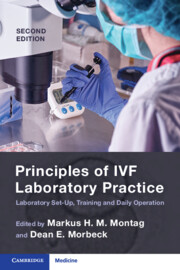Book contents
- Principles of IVF Laboratory Practice
- Principles of IVF Laboratory Practice
- Copyright page
- Contents
- Contributors
- Foreword
- The Evolution of IVF Practice
- Section 1 Starting a New Laboratory and Training Protocols
- Section 2 Pre-procedure Protocols
- Section 3 Gametes
- Chapter 14 Sperm Preparation for Therapeutic IVF
- Chapter 15 Processing Surgically Retrieved Sperm in the IVF Laboratory
- Chapter 16 Cryopreservation of Sperm for IVF
- Chapter 17 Oocyte Collection for IVF
- Chapter 18 In Vitro Maturation of Immature Oocytes for IVM–IVF
- Chapter 19 Oocyte Grading by Morphological Evaluation
- Chapter 20 Vitrification of Oocytes for IVF
- Section 4 Insemination/ICSI
- Section 5 Fertilization Assessment
- Section 6 Embryo Assessment: Morphology and Beyond
- Section 7 Embryo Cryopreservation
- Section 8 Embryo Transfer
- Section 9 Quality Management
- Index
- References
Chapter 20 - Vitrification of Oocytes for IVF
from Section 3 - Gametes
Published online by Cambridge University Press: 07 August 2023
- Principles of IVF Laboratory Practice
- Principles of IVF Laboratory Practice
- Copyright page
- Contents
- Contributors
- Foreword
- The Evolution of IVF Practice
- Section 1 Starting a New Laboratory and Training Protocols
- Section 2 Pre-procedure Protocols
- Section 3 Gametes
- Chapter 14 Sperm Preparation for Therapeutic IVF
- Chapter 15 Processing Surgically Retrieved Sperm in the IVF Laboratory
- Chapter 16 Cryopreservation of Sperm for IVF
- Chapter 17 Oocyte Collection for IVF
- Chapter 18 In Vitro Maturation of Immature Oocytes for IVM–IVF
- Chapter 19 Oocyte Grading by Morphological Evaluation
- Chapter 20 Vitrification of Oocytes for IVF
- Section 4 Insemination/ICSI
- Section 5 Fertilization Assessment
- Section 6 Embryo Assessment: Morphology and Beyond
- Section 7 Embryo Cryopreservation
- Section 8 Embryo Transfer
- Section 9 Quality Management
- Index
- References
Summary
Oocyte cryopreservation is of utmost importance in many aspects of assisted reproductive techniques (ART), offering several valid solutions to clinic, logistic and social problems. Unfortunately, until recently, oocyte cryopreservation has been largely neglected, mostly due to the remarkable technical difficulties related to cell special structure and sensitivity. Since the first human birth reported from a frozen egg, considerable efforts have been made to improve a defective protocol: cryopreservation systems evolved considerably during the years, shifting from conventional ’slow-freezing’ to more effective ’vitrification’ methods. Notably, the advent of vitrification dramatically increased the cryopreservation efficiency in terms of survival and, more importantly, pregnancy rates, such that it is today considered the method of choice to preserve both gametes and embryos, finally freed of the heavy label ’experimental’.
Keywords
- Type
- Chapter
- Information
- Principles of IVF Laboratory PracticeLaboratory Set-Up, Training and Daily Operation, pp. 151 - 158Publisher: Cambridge University PressPrint publication year: 2023



